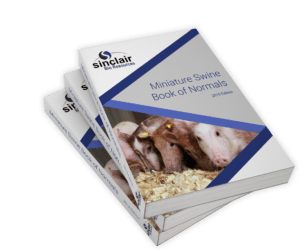Miniature swine present several attractive features to the osteoporotic scientist. They are polyestrous, omnivorous, small in body size, and have lamellar bone and trabecular and cortical remodeling similar to humans.
The miniature swine osteopenia and osteoporosis model is useful for bone loss studies as well as other categories of orthopedic research. For example, as the prevalence of postmenopausal osteoporosis increases, valid animal models are essential to evaluate bone active drugs for the prevention or treatment of osteoporosis.
Sinclair Bio Resources has contributed to the development of several osteopenia miniature swine models. A female young adult model is created by feeding a mildly restricted calcium diet beginning at four months of age and then performing ovariectomies at 10 months of age. This results in a reduction in trabecular bone and alteration of cancellous bone microstructure that appears to be primarily due to trabecular perforation.
In addition to the above young osteopenia model that results in significant bone loss and microstructural alterations in a compressed time period of 6 months, we are also evaluating adult miniature swine osteopenia models that will produce a gradual bone loss without growth artifacts. To achieve this purpose, the peak bone mass and calcium requirements of the Sinclair miniature swine were determined: peak bone mass occurs between 2.5 and 3 years of age and dietary calcium levels above 0.45% are adequate for adult Sinclair miniature swine. At 0.37% dietary calcium, serum PTH starts increasing which indicates that this calcium level may be the threshold of deficiency.
An adult model is created by giving ovariectomized adult females a moderate calcium diet. A limb suspension study using intact adult Sinclair miniature swine has also been very encouraging. Ten months after gastrocnemectomy, there was a bone density loss of 11.6% and 21.1% in the spine and femur, respectively, with approximately 80% of the bone loss occurring within 2 months after the injury.
Both of these models appear to be useful models of osteopenia and trabecular plate perforation and promising models for the study of the influence of microstructural changes on bone biomechanics.

